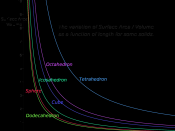[Type text] [Type text] [Type text]
An experiment on the effect of surface area to volume ratio on the rate of osmosis of Solanum tuberosum L.
Background
A cell needs to perform diffusion in order to survive. Substances, including water, ions, and molecules that are required for cellular activities, can enter and leave cells by a passive process such as diffusion. Diffusion is random movement of molecules in a net direction from a region of higher concentration to a region of lower concentration order to reach equilibrium. Diffusion does not require any energy input. Diffusion is needed for basic cell functions - for example, in humans, cells obtain oxygen via diffusion from the alveoli of the lungs into the blood and in plants water is obtained through the root hairs via osmosis.[1: http://www.tiem.utk.edu/~gross/bioed/webmodules/diffusion.htm]
Osmosis is a special kind of diffusion that involves water molecules passing through a partially permeable membrane, in this case, the plasma membrane of cells.
Cell membranes have tiny holes that allow small molecules to pass through but not larger ones. The rate of osmosis is dependent on many factors - temperature, pressure and surface area to volume ratio, which is being explored in this experiment.
Aim
The aim of this biology laboratory experiment is to explore the effect of surface area to volume ratio on the rate of osmosis of tap water of Solanum tuberosum L.
Solanum tuberosum L., also known as potato, was the selected plant to be tested because it was easy to measure the percentage change in mass due to the osmosis of water into the tissue.
Research Question
How does the surface area to volume ratio of potato tissue (Solanum tuberosum L.) affect the rate of osmosis of tap water?
Hypothesis
The smallest cube of potato (1x1x1), having a higher surface...


